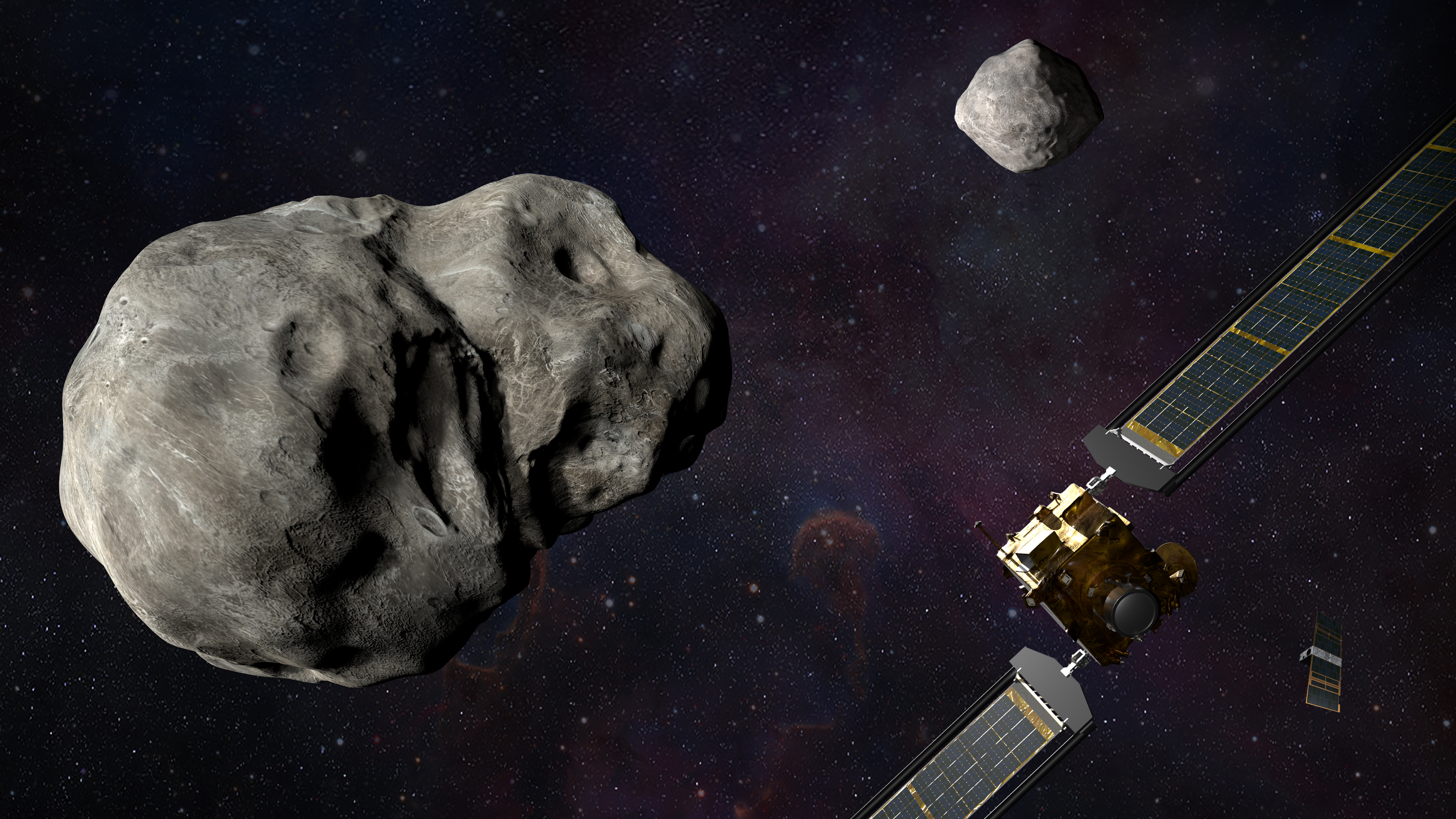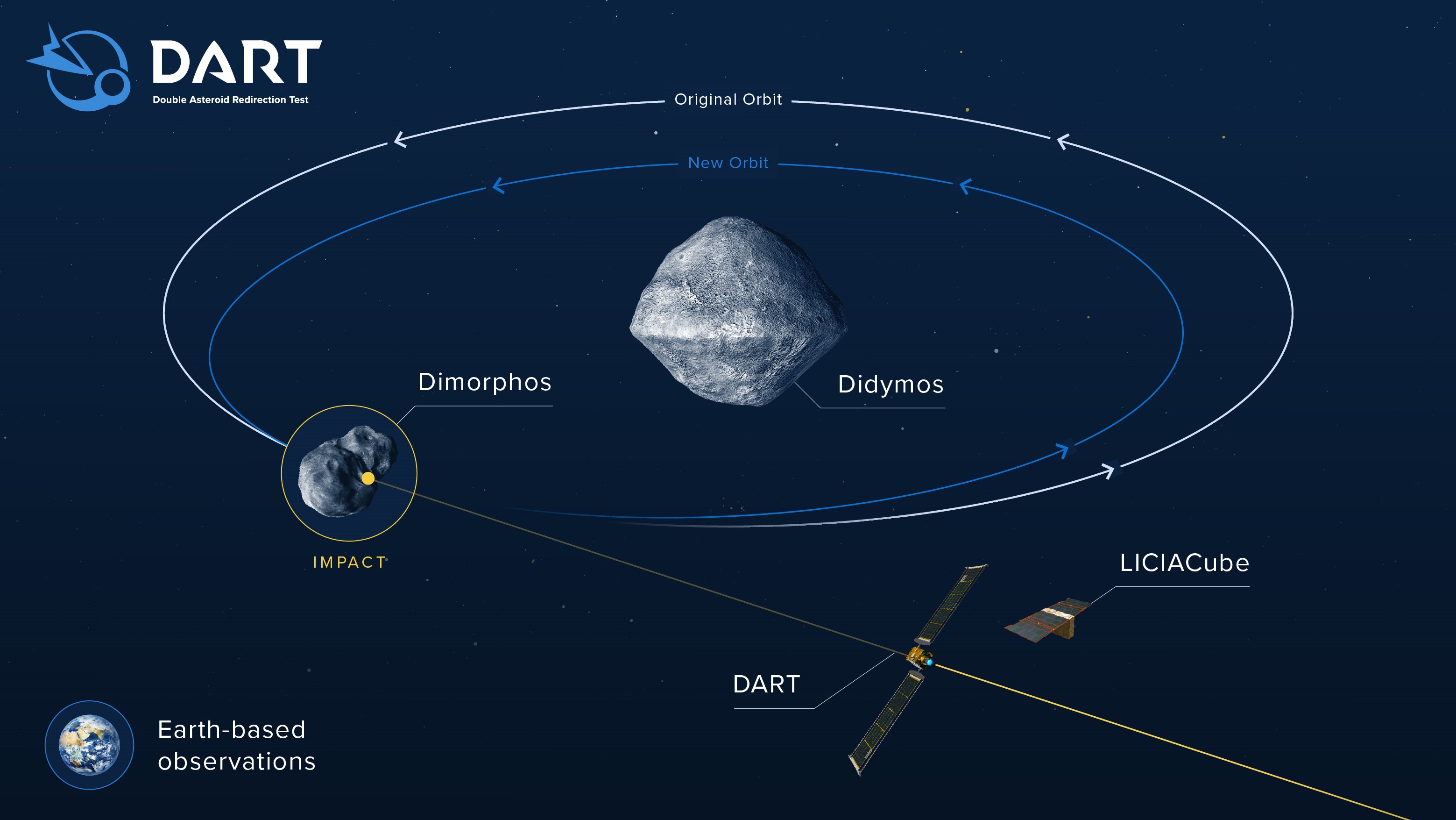NASA wants to smash a spacecraft into an asteroid, but don't worry. Earth isn't at risk.
The NASA DART asteroid mission launches Nov. 24 and will crash into the moonlet of asteroid Didymos in 2022.

Later this month, NASA will launch a mission to smack an asteroid into a new orbit to prepare for the possibility that an asteroid in the future might threaten Earth. But don't worry, experts agree that there is no possibility that (even if it goes awry) this asteroid-smashing could threaten Earth.
NASA's Double Asteroid Redirection Test mission, or DART, will essentially practice what the agency might do if a relatively large asteroid were on a trajectory to collide with Earth. The mission will attempt to hit a space rock nearly head-on, smashing into it and tweaking its orbit. DART will launch from Vandenberg Space Force Base in California aboard a SpaceX Falcon 9 rocket on Nov. 23 at 10:20 local time (Nov. 24 at 1:20 a.m. EST, 0620 GMT). If all goes well, it will crash into its asteroid target in late 2022.
However, even if the test doesn't go exactly according to plan, DART's target "has no chance of impacting the Earth whatsoever," astronomer Amy Mainzer, who is the principal investigator of NASA's Near-Earth Object Wide-field Infrared Survey Explorer (NEOWISE) mission and who specializes in characterizing populations of asteroids and comets, told Space.com.
Related: Humanity will slam a spacecraft into an asteroid to help save us all
DART will target the miniature asteroid moon Dimorphos that orbits around Didymos, the larger space rock in the system. Mission personnel chose this system specifically for a number of reasons, but importantly because it is far away from Earth.
"As of today, the distance to Didymos from Earth is 483.6 million kilometers [300 million miles]. But as Earth and Didymos pursue their orbits around the sun this distance varies between 10 and 493 million km [6 and 306 million miles] ," astrophysicist and satellite tracker Jonathan McDowell of the Harvard-Smithsonian Center for Astrophysics in Massachusetts told Space.com.
McDowell echoed Mainzer's evaluation and, when asked whether (even if things don't go according to plan) the DART mission posed any risk of setting any chunks of asteroid on a trajectory toward Earth, he responded, "no, not at all."
Get the Space.com Newsletter
Breaking space news, the latest updates on rocket launches, skywatching events and more!
DART is just a practice run in the possible event that there were a hunk of space rock hurtling towards our home planet. If this test proves successful, NASA could use this same type of technology to essentially push that threatening rock out of Earth's way.
But just how likely is it that such an event could take place? Is there really a possibility that an asteroid could threaten life on Earth as it has in the past with famous events like the Chicxulub impact that wiped out Earth's large dinosaurs?
"Good news is that's an incredibly unlikely scenario," Mainzer said. "Really large global events must be incredibly rare, or we human beings would not be here. I mean, if global extinction events were common, there's no way that you would have human life."

However, she added that "when you get to smaller sizes of impacts, ones that are not capable of causing necessarily global problems, but severe regional damage, there are a lot more of those objects out there, and those are potentially more frequent events." Mainzer did specify that when she says "frequent," she's talking in astronomical timescales, so frequent could mean hundreds of thousands of years or even longer.
That being said, Mainzer explained that our understanding of what exists "near," (near in astronomical terms, so it includes a fairly wide range) Earth. She added that she and others around the globe are continuing to work to fill in the gaps of understanding what objects exist near Earth. (Near-Earth objects include objects within 1.3 astronomical units, 120.9 million miles or 194.5 million km of Earth.)
She added that right now, we are aware of only about 30-40% of the large objects, or objects about 459 feet (140 meters) and larger, near our planet. "That's great, but it means we still have more work to do."
Mainzer, who explored the "what ifs" in her work as the science advisor on the comet-impact disaster dark comedy film "Don't Look Up" premiering in TK, is also working to fill in these knowledge gaps. "I am leading a new project that has recently been put into its preliminary design phase by NASA. It's called the NEO, or Near-Earth Object, Surveyor mission. And the objective of the mission is pretty straightforward, it's basically to go out and raise that completeness for the 140-meter objects," she said.
But, as we continue to learn more and more about what's "close" to Earth, Mainzer added that DART is giving us the protective tools we need.
"The importance of DART is that it will help to vet the technology that is needed, should we ever find something that does require mitigation, in the unlikely event that we do find something," she said. "The idea is that the technology will have been demonstrated before and it will be easier to build the next spacecraft. Because as you can imagine, it takes a lot of time to get a spacecraft together."
And time, Mainzer stressed, is key when it comes to battling an asteroid.
"The key ingredient for all of these mitigation strategies is time," she said. "You have to have enough time to do it. You have to have enough time to build the spacecraft. And even more, you have to have enough time because the more time you have, the less energy it requires, in general, to push an object."
Email Chelsea Gohd at cgohd@space.com or follow her on Twitter @chelsea_gohd. Follow us on Twitter @Spacedotcom and on Facebook.
Join our Space Forums to keep talking space on the latest missions, night sky and more! And if you have a news tip, correction or comment, let us know at: community@space.com.

Chelsea “Foxanne” Gohd joined Space.com in 2018 and is now a Senior Writer, writing about everything from climate change to planetary science and human spaceflight in both articles and on-camera in videos. With a degree in Public Health and biological sciences, Chelsea has written and worked for institutions including the American Museum of Natural History, Scientific American, Discover Magazine Blog, Astronomy Magazine and Live Science. When not writing, editing or filming something space-y, Chelsea "Foxanne" Gohd is writing music and performing as Foxanne, even launching a song to space in 2021 with Inspiration4. You can follow her on Twitter @chelsea_gohd and @foxannemusic.









